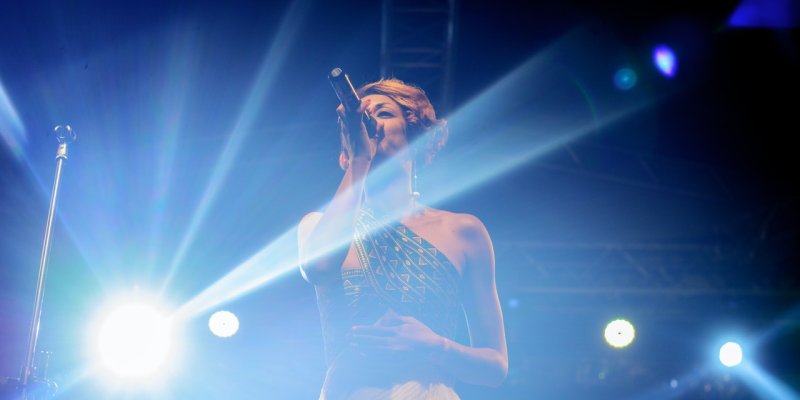
R&B, also written as RNB, stands for rhythm and blues and originated in the 1940s in America. While the phrase has stayed the same, the term "rhythm and blues" has gone through many changes throughout the decades.
When R&B first started, that rhythm came from the beats often found in jazz styles. When the 1950s came around, the rhythm was more influenced by the early sounds of rock.
In the 60s, with the rising popularity of British rock, rhythm and blues took on an even more rock-driven sound.
In the 70s and 80s, funk became the driving force in R&B. Now, contemporary styles of R&B, pop, and electronic music heavily influence our rhythm and blues.
Related Post: How To Sing R&B (Tips From A Successful Singer)
This genre of music typically features expressive and emotive vocal performances. Singers often employ melisma, vocal runs, and ad-libbing to add richness and passion to their delivery. Soulful, heartfelt singing is a hallmark of R&B.
R&B is driven by a prominent rhythm section, usually featuring a combination of drums, bass, and keyboard instruments like piano or organ.
The grooves in R&B songs are often infectious, with a focus on syncopation, steady beats, and a blend of influences from jazz, funk, and gospel.
The lyrics in this style often explore themes of love, relationships, heartbreak, and personal experiences.
The lyrics tend to be introspective, relatable, and convey strong emotions. R&B songs often tell stories or express the ups and downs of human emotions.
R&B is known for its smooth and sensual melodies that evoke a sense of intimacy. The melodies often incorporate melodic runs, chromaticism, and expressive phrasing.
R&B melodies can be catchy and memorable, while also maintaining a sense of sophistication and elegance.
Singers in this genre of music often emphasize vocal harmonies and layered background vocals. These harmonies add depth and texture to the music, creating a lush and full sound.
R&B vocal arrangements can feature intricate harmonies, call-and-response patterns, and overlapping vocal parts.
The term R&B originated in the 1940s to replace the term "race music" which was used to describe music popularly growing in African American culture and was deemed offensive as a term.
It was often confused for the term "jump blues", which was very similar and style and can be said to have birthed the genre of R&B.
According to Lawrence Cohn, author of Nothing but the Blues, R&B was a blanket term that could be used to describe any kind of African American music that was not religious, which often holds true of the term in the present.
R&B music in these two decades was heavily influenced by styles of jazz, blues, and a little bit of rock.
The largest influence was the style of boogie-woogie which was often found in upbeat blues and jazz performances and included instruments like the saxophone, trumpet, piano, and drums.
In the 1950s, Little Richard grabbed the attention of other genres and labels with a sound that would later be blended with Rock by famous stars like Elvis Presley.
In this era of R&B, rock ballads were often called R&B anthems due to British and American rock having a very heavy influence on the general music culture, which can also be stated as R&B having a heavy influence on rock music in the US and the UK.
In the 60s and 70s, a subgenre by the name of Soul sprang up in the African American music culture, with talented singers like Sam Cooke paving the way with smooth vocals and more relaxed, ballad-styled rhythms.
Funk and Disco came into the picture, and R&B became a blanket term for the three terms.
Related Post: Should Genres Be Capitalized When Written Or Typed?
In the 80s and 90s, ballads were a huge deal from great singers like Whitney Houston and Mariah Carey. Hip hop also largely influenced the sound of the genre and changed the way that rhythm became involved in the creation of rhythm and blues.
The R&B singles in the early 90s and 2000s hit R&B singles would almost always have a rapper featured alongside the singer or singing group. Hip-hop songs, in turn, often featured an R&B singer.
While the 1980s and beyond saw the term "contemporary R&B" being mentioned a lot, a newer style of contemporary music came along in the late 2010s.
These more modern songs brought a softer sung and more electronic side to the R&B world that spread to many countries and influenced styles like K-pop and J-pop.
Contemporary R&B still heavily relies on the style of hip hop and rap, with many singers showcasing rap talents in sing-style rapping and vice-versa.
In the past few years, many electronic and dance music styles began to blend their song influences with rap, trap, and R&B.
Related Post: A Breakdown Of Beyonce's Vocal Range

As a session singer, writer, and producer that has worked with over 300 clients to provide high-quality jingles, singles, and features, Yona spends her time creating and marketing new music and helpful resources for creators. Check out Yona’s latest releases on her Spotify, her Youtube and share if you like it!
If you are in need of singer, songwriter or song producer services, see what Yona Marie can offer you on her services page.